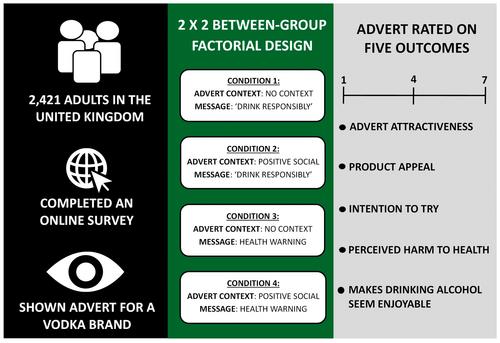Restricting the content of alcohol advertising and including text health warnings: A between-group online experiment with a non-probability adult sample in the United Kingdom
Abstract
Background
Statutory options for restricting alcohol advertising include limiting it to product-orientated information and requiring health warnings. We assess the impact of removing positive contextual factors from alcohol advertising and including a health warning among adults in the United Kingdom (UK).
Methods
We conducted a 2 × 2 online between-group experiment with adults (18+) (n = 2421) recruited from a non-probability research panel in the United Kingdom. Participants were randomized to see an alcohol (vodka) advertisement (advert) which varied by context (no context vs. imagery depicting positive social interactions around alcohol) and message (multiple text health warning vs. “drink responsibly”). The multiple text health warning, based on recent legislation in Ireland, comprised three separate warnings (liver disease, cancers, drinking during pregnancy) and a web address for alcohol-related information and support. The “drink responsibly” control reflected the self-regulatory messages commonly used by alcohol companies. Participants rated the advert on 7-point scales for advert attractiveness, product appeal, trial intentions, perceived harm, and whether it made drinking alcohol seem enjoyable.
Results
Removing the positive social context reduced positive advert and product reactions (difference in estimated marginal means [EMM]: −1.57 [makes drinking alcohol seem enjoyable] to −0.23 [intention to try]). Including the multiple text health warning also reduced positive advert and product reactions (difference in EMM: −0.55 [advert attractiveness] to −0.25 [intention to try]) and increased perceived product harm (difference in EMM: +0.25). There were no interactions between advert context and message for any outcome.
Conclusions
Restricting content and including a multiple text health warning (compared to a “drink responsibly” message) may attenuate the persuasive impact of alcohol advertising and increase perceived product harm. Further research is needed to examine different degrees of content restrictions, alternative warning content and design, generalizability to different alcohol products and advert formats, and whether the impact of content controls varies among population subgroups.


 求助内容:
求助内容: 应助结果提醒方式:
应助结果提醒方式:


